Regency Dance Progression: Difference between revisions
(Created page with "right|450px|''See also the article Regency Dancing by Rose'' ''Part of the [[|Category:Articles]] series. Article by Sharpie...") |
No edit summary |
||
| Line 1: | Line 1: | ||
[[File:Two pairs in a country dance.jpg|right|450px|]]''See also the article [[Regency Dancing]] by Rose'' | [[File:Two pairs in a country dance.jpg|right|450px|]]''See also the article [[Regency Dancing]] by Rose'' | ||
''Part of the [[Category:Articles]] series. Article by [[Sharpie]]'' | ''Part of the [[:Category:Articles]] series. Article by [[Sharpie]]'' | ||
[[File:Fig 1.jpg|thumb| | [[File:Fig 1.jpg|thumb|450px|Starting positions]] The most common type of dance during the Regency era was the 'country dance', a term corrupted from the French 'contre danse', 'contre' meaning opposite, which shows the nature of these dances: The dancers stand in two long lines, men opposite their female partners. This is a 'set' and there may be more than one set dancing, depending on the size of the room and the number of dancers. | ||
Revision as of 07:10, 16 February 2017

See also the article Regency Dancing by Rose
Part of the Category:Articles series. Article by Sharpie
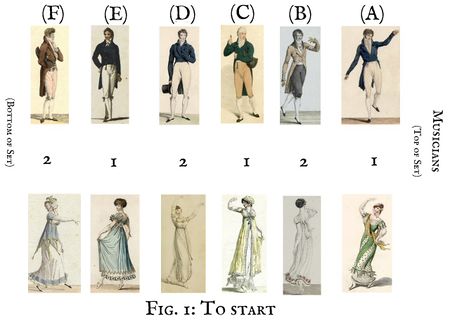
The most common type of dance during the Regency era was the 'country dance', a term corrupted from the French 'contre danse', 'contre' meaning opposite, which shows the nature of these dances: The dancers stand in two long lines, men opposite their female partners. This is a 'set' and there may be more than one set dancing, depending on the size of the room and the number of dancers.
The dancers form up with the musicians on the left of the men, and on the right of the ladies. The couple nearest the musicians are in the position of honour at the top of the set and lead the dance; it is entirely dependent on the woman's rank socially. If a ball was given in a woman's honour, as the Fitzgerald Ball is given for Olivia Fitzgerald, to mark her coming Out into society, then the guest of honour leads the dancing and opens the ball as part of the first couple in the first set.
The dancers didn't stay in the positions in which the dance began, for that would be a very short and uninteresting dance. So, with illustrations that will (I hope!) help those of you who can't otherwise visualise it, this is my better attempt at explaining how couples move up and down a set, and what determines which direction they're going. I am not going to give any actual steps for any actual dance - I'll link to a resource site for those at the end of this piece.
This works for every dance, no matter what the steps involved are. There may be movement around between couples before the dance has actually progressed, but the odd-numbered couples move down (and the even numbered couples move up) and the pattern repeats.
My lovely models are all wearing evening dress for this demonstration, naturally.
The first picture shows our twelve dancers ready to begin. (Fig. 1) The letters in brackets at the top are to help show the order the dancers were in to start, and how the progression moves each individual couple in the set.
Beginning the Dance
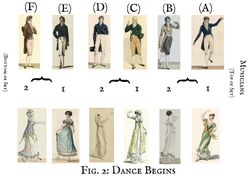
Before the dance begins, the dance group I go to starts by taking hands in fours from the top of the set – this shows which couples will be dancing together to start – those facing down the set are Number Ones, those facing up are Number Twos – shown in Fig. 2. This illustration shows how the dance actually works as three pairs of couples – three foursomes – who will be dancing the first repetition. One repetition or iteration, only lasts for a few bars of music.
The curly brackets { are to help show which couples are forming a foursome at any one time, and apply to the men and women equally; I just put them in the middle of the set for visibility.
As the music starts, the gentlemen make their bows and the ladies courtesy before the actual dance begins.
First Progression
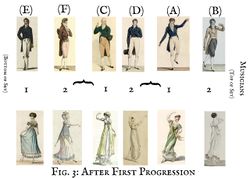
Different dances require different sequences of steps; for instance, one dance may require a right-hand star (everyone in a foursome puts their right hands into the centre and moves around clockwise) followed by a left-hand star, and another may require that each couple take hands and does a two-hand turn, or the Number One couple join hands and lead down the set for a count of of four before turning to come up into the place of the Number Two couple.
Whatever the actual sequence of the steps, the very first part of the dance will end with odd and even numbered couples having swapped their positions within the set – the Number One couples will now be standing to the other side of the Number Twos, and will be looking to the next Number Two pair to begin the sequence again. This is the first progression – Fig. 3.
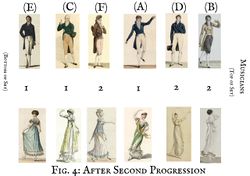
After the first progression, the pattern of the dance begins over again, but in a new foursome as the Ones have moved down the set and the Twos have, correspondingly, moved up. Each couple repeats the exact same sequence of steps they have just done, but with the new couple, and this sequence likewise ends with the Number Ones moving down the set by switching places with the Number Twos. (Fig 4.)
This means that the couples who are now standing at the top and bottom of the set are out for a turn because they have nobody to make a foursome with until after the next progression. (Couples B and E here.)
Second Progression
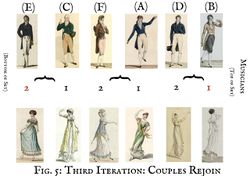
After the second progression, it now appears that there are two Number One couples at the bottom of the set and two Number Two couples at the top of the set. Now, those who stood out for a turn come back in – BUT. They are now dancing the opposite part of the sequence – the couple who was a One is now a Two, and moving back up the set.
Fig 5 shows how Couple B who stood out for a moment while the dance continued, have now come back in, to make a foursome with Couple D, who are still moving up the set. Couple A will now be dancing with Couple F and rather than having two couples standing out at the top and bottom of the set, Couples B and E rejoin the dance, but doing the sequence and set of steps that will bring them to the other end of the set from where they are now: Their numbers have changed (shown by colouring their numbers in red here).
The Dance Progresses
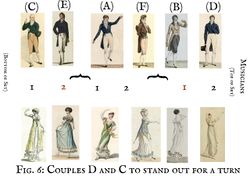
The dance progresses in the same way, with each couple standing out in turn until the top couple (Couple A, with the lady in green) has made it all the way down to the bottom of the set doing the Number One steps of the dance and all the way back up to the top doing the Number Twos steps of the dance.
Halfway through the dance with our six-couple set and the two couples who began the dance in the middle of the set have now reached the top of the set (Couple D, who began by doing the Number Twos steps) and the bottom (Couple C, in the Number 1 position in the dance). After the next progression, they will join back in to form foursomes with Couples A and F, who have nearly reached the other end of the set from where they began and who will stand out themselves for a turn once they are there.
Theoretically at least, this progression means that every couple dances in every place in the set. In practice, it would be the top set with the most important people who would do this, and if other sets had more people, then they might not have reached their starting point in the set when the music ended.
The hardest position to begin a dance is second from the top or second from the bottom (Couples B and E in this six-couple set illustration) as these dancers complete one pattern before standing out and then coming back in with a slightly different pattern to make as they are now moving the other way in the set as the dance progresses.
Sets with an Odd Number of Couples
The only difference with sets with an odd number of couples is that instead of two couples standing out after every progression, only one couple stands out at a time, but it alternates: For the very first sequence, the bottom couple stand out, and then the Couple B (who started second from top) have reached the top position and stand out.
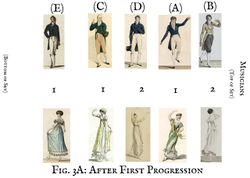
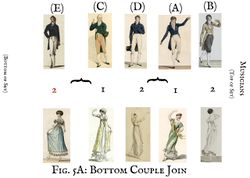
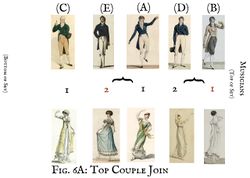
Resources
For a really good resource on the actual floor patterns and sequences, I recommend Regency Dances – but remember that they only show three couples and therefore cannot show that the third couple in a longways set is doing the same steps with the fourth couple as the first couple is doing with the second (in my pics above, C and D are doing together exactly what A and B are doing together). There are dances which are danced by three couples, but they are fundamentally different and involve everyone with the top couple dancing part of the sequence with each of the other two couples.